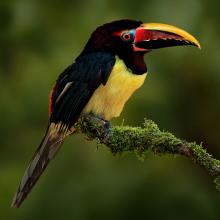
The Green Araçari, the smallest breed of toucans, is named for the green feathers that cover its back. They weigh between 110 to 160 grams and measure approximately 30 to 40 centimeters in size.
These frugivorous birds primarily feed on fruit, but insects also make up a small part of their diet, providing them with protein. They exhibit social behavior, often congregating in small groups in the treetops, where they forage and feed together.
These toucans have adapted long, serrated beaks to aid in gripping and gathering fruit. They also engage in bill-fencing and wrestling, likely to establish hierarchy within their groups. Similar to other toucan species, Green Aracaris release excess body heat through their beaks.
One interesting feature of Green Araçaris is their dimorphism, as females have a chestnut brown head and neck, while males have a black head and neck. Males typically live for about 14 years, while females have a lifespan of around 10 years.
Green Araçaris nest in tree cavities and typically produce 2 to 4 white eggs. The female takes on most of the incubation duties, but the male will incubate sometimes. Incubation lasts approximately 16 to 19 days. After the eggs hatch, the young birds remain in the nest for about 40 to 50 days, then continue to stay with their parents until they are 6 months old.
The Green Araçari is classified as "Least Concern" on the IUCN Red List with a stable population. However, with the ongoing loss of suitable habitat due to deforestation, their numbers are expected to decline in the future.
